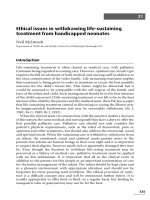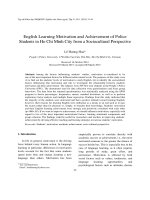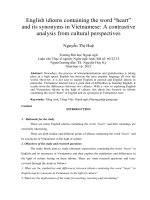In vitro drug release mechanism from cholesteryl ester composed liquid crystalline system
Bạn đang xem bản rút gọn của tài liệu. Xem và tải ngay bản đầy đủ của tài liệu tại đây (1.77 MB, 109 trang )
IN VITRO DRUG RELEASE MECHANISM FROM
CHOLESTERYL ESTER-COMPOSED LIQUID
CRYSTALLINE SYSTEM
WU JIAO
(B.Sc (PHARMACY), SHENYANG PHARMACEUTICAL UNIVERSITY,
CHINA)
A THESIS SUBMITTED
FOR THE DEGREE OF MASTER OF SCIENCE (PHARMACY)
DEPARTMENT OF PHARMACY
NATIONAL UNIVERSITY OF SINGAPORE
2009
ACKNOWLEDGEMENTS
I would like to take this opportunity to thank the following individuals:
My supervisors, A/Prof Lawrence Ng Ka Yun and A/Prof Paul Heng Wan Sia, for their
support, guidance and great patience during the whole course of this project.
The Head of Department, A/Prof Chan Sui Yung, and the staff of Department of
Pharmacy for the use of departmental facilities.
Mdm Leng Lee Eng for DSC experiments and Mdm Tan Geok Kheng for x-ray
diffraction studies.
Laboratory officers, Lye Pey Pey, Teresa Ang and Lee Pei Ying for their help with
purchase of the chemicals and necessary technical training for use of the instruments.
My colleagues in the Department of Pharmacy for their friendship and support.
My parents, grandparents and close friends for their unwavering support and
encouragement especially when I was in low spirits and unmotivated.
Finally, to National University of Singapore for the generous support by providing me the
Graduate Research Scholarship to study in Singapore which I gratefully acknowledge.
ii
Table of Contents
Page
Acknowledgements
ii
Table of Contents
iii
Abstract
vii
List of Tables
viii
List of Figures
ix
CHAPTER 1 INTRODUCTION
1.1 Description of the problem
1
1.2 Purpose of the study and objectives
2
1.3 Research hypothesis and rationale for hypothesis
2
CHAPTER 2 THE MESOMORPHIC STATE: LIQUID CRYSTALS
2.1 Liquid crystal definition, classification and network structure
3
2.2 Lyotropic liquid crystals
6
2.3 Thermotropic liquid crystals
8
2.4 Phase transition between states
11
2.5 Mixed liquid crystals
13
2.6 Viscosity
14
2.7 Liquid crystal stabilization
17
iii
CHAPTER 3 APPLICATION OF LIQUID CRYSTALS AND LIQUID
CRYSTALLINE FORMULATIONS
3.1 Application of liquid crystals in daily life
19
3.2 Application of liquid crystal formulations in drug delivery
20
3.2.1 Lamellar phases
22
3.2.2 Cubic phases
24
3.2.2.1 Glyceryl monooleate (GMO)-water system
26
3.2.2.2 Pluronic F127 system
27
3.2.2.3 Ringing gels
28
3.2.2.4 Biosensor and biochips
29
3.2.2.5 Cubic phase particles (Cubosomes)
29
3.2.3 Smectic supercooled nanoparticles
31
3.2.4 Liquid crystal-embedded membranes
32
3.3 Formulations / Uses of liquid crystals in cosmetics
33
CHAPTER 4 PHYSICOCHEMICAL CHARACTERIZATION OF LIQUID
CRYSTALS
4.1 Introduction
4.1.1 Differential scanning calorimetry (DSC)
35
4.1.2 X-ray diffraction (XRD)
35
4.1.3 Determination of drug solubilities in semisolids
37
4.2 Materials and methods
4.2.1 Materials
37
iv
4.2.2 Melting point detection
38
4.2.3 Sample preparation
39
4.2.4 Solubility and homogeneity determinations
40
4.2.5 Polarized light microscopy (PLM)
40
4.2.6 X-ray diffraction (XRD)
40
4.2.7 Differential scanning calorimetry (DSC)
41
4.2.8 Fourier transform infrared spectroscopy
41
4.3 Results and discussion
41
4.4 Conclusion
52
CHAPTER 5 IN VITRO DRUG RELEASE STUDY
5.1 Introduction
5.1.1 In vitro release test apparatus
54
5.1.2 Drug release theory
56
5.2 Materials and methods
5.2.1 Franz diffusion cell system
58
5.2.2 Sample analysis
59
5.2.3 Release rate determination
59
5.2.4 Dissolution data analysis
60
5.3 Experimental results
5.3.1 Influence of temperature
61
5.3.2 Influence of initial drug loading
64
5.3.3 Influence of liquid crystal structure
66
v
5.3.4 Influence of physical state of drug in the matrix
67
5.3.5 Evaluation of drug release mechanism
69
5.4 Discussion
72
5.5 Conclusion
74
CHAPTER 6 SUMMARY AND FUTURE DIRECTIONS
75
Appendix Ι
Fickian diffusion model
78
A1.1 Fick’s first law of diffusion
78
A1.2 Fick’s second law of diffusion
78
Appendix П
Abbreviations used
82
References
vi
IN VITRO DRUG RELEASE MECHANISM FROM
CHOLESTERYL ESTER-COMPOSED LIQUID CRYSTALLINE
SYSTEM
Master of Science (Pharmacy) 2009
Wu Jiao
Department of Pharmacy
National University of Singapore
ABSTRACT
The present study has investigated the in vitro ibuprofen release profiles from a liquid
crystalline system, which is composed of cholesteryl nonanoate (CNN), cholesteryl
chloride (CCL) and cholesteryl oleyl carbonate (COC), with a combination ratio of
CNN/COC/CCL=10/80/10 w/w/w. The presence of organized liquid crystalline
structures was confirmed by polarizing light microscopy and x-ray diffraction, and the
structures were shown to remain relatively unchanged after drug loading. The inclusion
drug molecules remained in a molecularly distributed amorphous state as no crystalline
drug evidence was found in the matrix as shown by DSC and x-ray diffraction studies.
Drug-carrier interactions were probably mediated through van de Waals or dipole-dipole
interactions because FTIR spectra revealed absence of hydrogen bonding interaction
within the liquid crystalline matrix. The in vitro ibuprofen release profiles most aptly
fitted to the square root Higuchi release model, indicating that drug release was
predominantly controlled by Fickian diffusion. Drug release was influenced by the phase
transition of the liquid crystalline matrix, initial drug loading, as well as the viscosity of
the matrix system.
vii
List of Tables
Table 2.1 Liquid crystal formation by drugs (Müller-Goymann, 2004)
Table 2.2 Mesophase classifications and characteristics
Table 3.1 Examples of applications of liquid crystal formulations in drug delivery
Table 3.2 Examples of drugs incorporated in smectic nanoparticles
Table 4.1 Chemical structures of cholesteryl esters and ibuprofen
Table 4.2 Melting point (ºC) and d001 spacing (Ǻ) data of cholesteryl esters and
ibuprofen
Table 4.3 Cholesteryl liquid crystal mixtures (w/w/w) and their phase transition
temperatures (ºC)
Table 5.1 Average difference between two dissolution profiles of reference batches
(Shah et al, 1998)
Table 5.2 Similarity factor (f2)
Table 5.3 Goodness of fit (r2) of dissolution data for the drug release mathematical
models
viii
List of Figures
Fig 2.1 Thermotropic liquid crystals (with the increase of temperature): (a) crystal ; (b)
smectic; (c) nematic; (d) liquid.
Fig 2.2 Lyotropic liquid crystals: (a) hexagonal mesophases; (b) cubic mesophases; (c)
lamellar mesophases
Fig 2.3 Chemical structure of cholesteryl esters (R= CxHy, number of carbons: 1 to 20+,
number of double bonds: 0 to 3)
Fig 4.1 Polarizing light microscopy of (a) liquid crystal matrix and (b) liquid crystal
matrix with excess ibuprofen not fully dissolved (needle like, distinctive birefringence).
Magnification 100×.
Fig 4.2 Plots of phase transition temperatures of mixed liquid crystalline systems as a
function of the concentration of COC, w/w (A) and the concentration of CNN, w/w (B).
Fig 4.3 DSC thermograph of ibuprofen
Fig 4.4 DSC heating and cooling curves (5ºC/min) of liquid crystalline matrices with
and without ibuprofen loaded. The three cycles are noted as C1 (first heating), C2
(cooling) and C3 (second heating). Systems are (A) liquid crystalline matrix
(CNN/COC/CCL = 10/80/10, w/w/w); (B) liquid crystalline matrix (same as (A)) loaded
with 1 %, w/w ibuprofen.
Fig 4.5 XRD pattern of ibuprofen with characteristic peaks at (a) 6.1º; (b)12.2º; (c) 16.6º;
(d) 19.0º; (e) 22.3º (2θ)
Fig 4.6 XRD pattern of liquid crystal (LC; CNN/COC/CCL=10/80/10, w/w/w) with and
without ibuprofen at the concentration of 1% w/w at different temperatures below and
above phase transition temperature: (a) LC, 30ºC, 17.6º (2θ); (b) LC, 45ºC, 17.6º (2θ); (c)
LC+1%IBU w/w, 30ºC, 18.02º (2θ); (d) LC+1%IBU w/w, 45ºC, 18.02º (2θ).
Fig 4.7 FT-IR spectra of ibuprofen (A); liquid crystal carrier
(CNN/COC/CCL=10/80/10, w/w/w) (B); liquid crystal carrier (same as (B)) loaded with
ix
1 % ibuprofen (w/w) (C); liquid crystal carrier (same as (B)) loaded with 10 % ibuprofen
(w/w) (D); physical mixture of liquid crystal carrier (same as (B)) with 10 % ibuprofen
(w/w) (E); physical mixture of liquid crystal carrier (same as (B)) with 20 % ibuprofen
(w/w) (F).
Fig 5.1 Design of the vertical Franz diffusion cell used in the Microette and
MicroettePlus system (Shah et al., 2003).
Fig 5.2 Cumulative amount of ibuprofen released per unit surface area from the liquid
crystalline matrix (CNN/COC/CCL=10/80/10, w/w/w) at different temperatures below
and above the phase transition temperature of the liquid crystal blends at drug loadings of
(a) 0.5 %; (b) 1 %; (c) 2 % (n=3, ± S.D.).
Fig 5.3 Cumulative amount of ibuprofen released per unit surface area from the liquid
crystalline matrix (CNN/COC/CCL=10/80/10, w/w/w) at different temperatures below
and above the phase transition temperature of the liquid crystal blends at drug loading of
1% (n=3, ± S.D.).
Fig 5.4 Cumulative amount of ibuprofen released per unit surface area as a function of
time from the liquid crystalline matrix (CNN/COC/CCL=10/80/10, w/w/w) at the
temperature of 34ºC at drug loadings of 0.5, 1, 2 and 5 % (n=3, ±S.D).
Fig 5.5 Plot of release rate, as a function of initial ibuprofen loading at the temperature
of 34ºC (mean ± S.D.)
Fig 5.6 Plots of the percent released of ibuprofen from the liquid crystalline matrix
(CNN/COC/CCL =10/80/10, w/w/w) at drug loadings of 0.5, 1, 2 and 5 % at 34ºC (n=3,
±S.D.)
Fig 5.7 Comparison between two liquid crystalline systems (a)
CNN/COC/CCL=10/80/10, w/w/w; (b) CNN/COC/CCL=56/34/10, w/w/w : (A)
cumulative amount of ibuprofen released per unit surface area as a function of square root
of time at the temperature of 44ºC from (a) and (b); (B) XRD patterns of system (a) and
(b) at the temperature used to study drug release.
Fig 5.8 Plots of the rate of ibuprofen released from liquid crystalline system
(CNN/COC/CCL =10/80/10, w/w/w) at drug loading of 2% w/w at 34ºC as a function of:
(A) 1/ (amount of drug released) and (B) amount of drug released. The rates values were
obtained from the release profiles represented in Fig. 5.4.
x
CHAPTER 1. INTRODUCTION
1.1 Problem Statement
Ibuprofen (IBU), α-methyl-4-(2-methylpropyl)-benzene acetic acid, is a non-steroidal
anti-inflammatory drug (NSAID) used to treat rheumatoid arthritis, osteoarthritis and
mild to moderate pain. The gastrointestinal irritation and ulcerogenic effects along with
short half-life (1.8 - 2.0 h) of IBU have led to the design of sustained release formulations
of IBU (Maheshwari et al. 2003). Due to its low melting point and hydrophobic nature
(log P = 3.5), it was chosen as a model drug in this study.
Liquid crystals as drug delivery systems have been reported to be able to improve the
dissolution of poorly water-soluble drugs. It is known that lyotropic liquid crystalline
phases can provide a slow release matrix for incorporated active molecules (Drummond
and Fong, 1999). Lyotropic liquid crystalline phases have the ability to incorporate
solutes (drugs) into their structures and the release behavior of the incorporated drugs
obeyed Higuchian kinetics in many cases (Boyd et al. 2006, Shah et al. 2001).
Thermotropic liquid crystalline phases have similar potential to incorporate hydrophobic
drugs and the change of the physical structure can be controlled by temperature change in
many reports (Lin et al. 2000, Dinarvand et al. 2006). However, until recently, there
have been few reports on the drug release mechanism from thermotropic liquid
crystalline systems.
1
Drug release rate from the liquid crystalline matrix is dependent on several factors related
to both the drug and the matrix. These factors include temperature, initial drug loading,
water content, the structure of the system as well as the physical properties of the
incorporated drug. These factors are critical in understanding the drug release
mechanism from the liquid crystalline matrix and thus,require more in-depth studies.
1.2 Purpose of the Study and Objectives
The purpose of the project is to develop a drug delivery system that releases drugs in a
controlled manner in response to changes in temperature.
The specific objectives of the project are: (a) investigate in vitro drug release mechanism
from the liquid crystalline structure; and (b) correlate drug release kinetics with
temperature change, initial drug loading and system viscosity.
1.3 Research Hypothesis and Rationale for Hypothesis
It is hypothesized that liquid crystals of similar chemical structures can be mixed together
to form a single composite liquid crystal. By mixing the components in different ratios, it
is possible to design a liquid crystalline system with a desirable phase transition
temperature. Because of their hydrophobic nature and liquid crystalline structure, liquid
crystal mixtures are able to incorporate hydrophobic drugs. Phase transition temperature
would influence the structure of the liquid crystalline system, thus acting as an on / off
switch for the release of the incorporated drug. The drug release from the liquid
crystalline system will follow a certain drug release mechanism, and be influenced by
several factors.
2
CHAPTER 2. THE MESOMORPHIC STATE: LIQUID CRYSTALS
2.1 Liquid Crystal Definition, Classification and Network Structure
In 1888, Reinitzer observed that on heating, cholesteryl benzoate “melted” first to a
viscous turbid liquid and then, some degrees higher, became optically clear. In 1889,
Lehmann studied the intermediate turbid phase and called it “Fliessende Krystalle” or
“Flűssige Krystalle” (flowing or fluid crystals). Friedel called this the mesomorphic state,
i.e. a state between solid and liquid (Brown et al. 1957).
Liquid crystals are typically elongated organic molecules with an uneven distribution of
electrical charges along their axes (dipole). This gives rise to a special physical
characteristic to which liquid crystals owe their name: between the crystalline and liquid
statesthey exhibit a further state of aggregation, namely the liquid crystalline or
mesophase. In this phase, the liquid crystal molecules are aligned parallel to each other
but are able to rotate about their long axes.
A prerequisite for the formation of liquid crystalline phases is an anisometric molecular
shape, which is generally associated with a marked anisotropy of the polarizability.
Molecules that can form mesophases are called mesogens. The latter are often excipients
e.g. surfactants. Even drug compounds themselves, e.g. the salts of organic acids or
bases with anisometric molecular shape, may fulfill the requirements for the liquid crystal
formation (Müller-Goymann, 2004) (Table 2.1).
3
Table 2.1
Liquid crystal formation by drugs (Müller-Goymann, 2004)
Drug
Arsphenamine
Disodium cromoglicinate
Nafoxidin-HCl
Diethylammonium flufenamate
NSAID salts
Fenoprofen
Ketoprofen
Ibuprofen
Flurbiprofen
Pirprofen
Diclofenac
Peptide hormone LH-RH analogue
Type of liquid crystal
Nematic
Nematic, hexagonal
Hexagonal, cubic, lamellar
Lamellar
Lamellar
Lamellar
Lamellar
Lamellar
Lamellar
Lamellar
Starting with the crystalline state, the mesophase is reached either by increasing the
temperature or by adding a solvent. Accordingly, thermotropic or lyotropic liquid
crystals are formed. As with thermotropic liquid crystals, variation in temperature can
also cause a phase transformation between different mesophases of lyotropic liquid
crystals.
There are different types of molecular arrangement in thermotropic liquid crystals:
smectic, nematic or cholesteric. The term smectic (soap-like) was coined by Friedel
(Oswald et al. 2005) from the Greek σμεγμα, meaning grease or slime. The smectic
structure is stratified as the molecules are arranged in layers with their long axes
approximately normal to the plane of the layers. The term nematic was coined by Friedel
from the Greek νημα, meaning thread. The term is used literally to describe the threadlike lines which are seen in the nematic structures under microscopic observation. In the
nematic structure, the only restriction on the arrangement of the molecules is that the
4
molecules preserve a parallel or nearly parallel orientation. A third structure has been
described in the literature, the cholesteric, so called because it is shown mainly by
cholesteryl derivatives.
(a) crystal
(b) smectic
(c) nematic
(d) liquid
Fig 2.1 Thermotropic liquid crystals (with the increase of temperature): (a) crystal ; (b)
smectic; (c) nematic; (d) liquid.
Materials that form liquid crystals by addition of solvents are referred to as lyotropic
liquid crystals, i.e. when present in aqueous solutions the concentration of water-soluble
amphiphiles is increased. The amphiphilic molecules must exhibit some chemical
complexity otherwise they will dissolve in the solvent instead. Liquid crystals are
typically organic molecules, ranging from small molecules (e.g. detergents) to
polyelectrolytes (e.g. DNA, vegetable gums). The formation of lyotropic mesophases is
driven by the chemical structure of the organic molecule(s), the ratio of water to
amphiphile(s) and the temperature. With decreasing water concentration, hexagonal
(similar to many cylinder-like micelles) and then lamellar phases (similar to stacked
bilayers, discoid) are formed. In the case of molecules with very polar head groups
5
which has high water binding capacities, cubic phases (“balls”) may be formed instead of
hexagonal arrangement.
The mesophase classifications and characteristics are summarized in Table 2.2.
Table 2.2 Mesophase classifications and characteristics
Mesophase
Phase
Classification
Transition By
a) Thermotropic
Mesogen
Characteristics
Smectic
Rigid part +
Layered, 1-(2-)D
one/two flexible lattice, with
aliphatic chains orientation,viscous
fluid
Temperature
Mesophase
Characteristics
Nematic
Thread-like, no
lattice, with
orientation, less
viscous
Cholesteric
Twisted or helical
structure, more
fluidwith color
Example
Cholesteryl
esters
b) Lyotropic
Lamellar
Cubic
Hexagonal
Concentration
Amphiphilic
molecules
(surfactants)
Stacked bilayers
Phospholipids
Balls-like
Cylinder-like
micelles
2.2 Lyotropic Liquid Crystals Surfactants (surface-active agents) are materials that
possess both a polar entity (the head group) and a non-polar paraffin chain in the same
molecule.
6
When water is added to solid surfactants, three types of behavior can occur:
(1) The surfactant is practically insoluble, and remains as a solid crystal plus an
aqueous solution of surfactant monomers.
(2) Some of the surfactant dissolves to form an aqueous micellar solution.
(3) A lyotropic liquid crystal is formed above certain concentration.
Surfactants that are almost insoluble in water are non-polar and semi-polar lipids, and
polar surfactants at temperatures below the Krafft point. Above the Krafft point, most
surfactants have a narrow temperature region (≈10K) where they form micelles but not
liquid crystals. Over most of the temperature range between the Krafft point and the
surfactant melting point, lyotropic liquid crystals are formed. Within the temperature
range 273-473K, lyotropic liquid crystals occur at least as frequently as micellar solutions,
if not more so. Some surfactants that do not form micelles can form liquid crystals.
Lyotropic liquid crystals are frequently encountered in everyday life, although their
presence is not normally recognized. They occur during the dissolution of soaps and
detergents, and a few products of this type are even sold in a liquid crystalline form.
They occur also during cooking, for example, cake batters often contain a liquid crystal
stabilized emulsion. In the industrial sector, the best known example of the use of
lyotropics is the occurrence of neat phase during soap manufacture. Similar phases occur
during the processing of other detergent products. For biologists, the bilayer arrangement
of molecules in the lamellar liquid crystalline phase is commonly encountered since this
unit forms the fundamental structure of most biological membranes.
7
The most common lyotropic liquid crystalline structure is the lamellar phase, followed by
the hexagonal phase and the reversed hexagonal phase (Fig.2.2). Least common are the
various cubic phases which are normally observed only over limited temperature and
composition ranges. In considering the factors responsible for the formation of any
lyotropic liquid crystalline phase, two properties of the particular surfactant(s) appear to
be important. These are:
(1)
The magnitude of the repulsive forces between adjacent head groups at the
surfactant / water interface. Important factors here are the head group,
strength of head group hydration and alkyl chain steric requirements and
whether the adjacent surfactant molecules have like, unlike or zero charge.
(2)
The degree of alkyl chain/water contact and the amount of conformational
disorder in the alkyl chains which are influenced by the number, length and
degree of unsaturation of the alkyl chains.
(a)
(b)
(c)
Fig 2.2 Lyotropic liquid crystals: (a) hexagonal mesophases; (b) cubic mesophases; (c)
lamellar mesophases (adapted from
/>
2.3 Thermotropic Liquid Crystals
8
Common thermotropic liquid crystals are composed of derivatives of cholesterol,
C27H46O. The cholesteric derivatives (cholest-5, 6-en-3β-R) are made up of 27 carbon
atoms and have 17 of these carbon atoms bonded together in such a way as to form a
rugged, not easily deformed nucleus or skeleton. These 17 carbon atoms are held
together in three six-numbered rings and one five-numbered ring; a pattern which is
quasiplanar. At one edge of the skeleton are three side chains, two of which are made up
of only one carbon atom. The 17β substituent consists of a chain of eight carbon atoms.
All of these chains project above the plane of the skeleton. At the opposite end of the
skeleton and also projecting out of a plane, an R group is attached in the 3β position. The
3β substituent extends the molecular long axis and favors mesophase formation. The
mesophase is formed by cholesteric derivatives only when the substituents are in the 3β
position, and when rings A and B are quasiplanar. The 17β side chain is not a critical
feature for the preservation of cholesteric properties (Tai et al. 1990).
H3C
CH3
CH3
CH3
H3C
O
R
O
Fig 2.3 Chemical structure of cholesteryl esters (R= CxHy, number of carbons: 1 to 20+,
number of double bonds: 0 to 3)
9
Characteristically, cholesteryl esters exhibit two mesophases: the smectic mesophase and
the cholesteric mesophase. The smectic mesophase is a slightly turbid, viscous state
which displays focal conic textures with a positive sign of birefringence under a
polarizing microscope. The cholesteric mesophase appears at temperatures higher than
the smectic mesophase and is also slightly turbid, but is more fluid than the smectic phase
and often exhibits a variety of colors by virtue of its long-range twisted or helical
structure. Microscopically, this mesophase exhibits focal-conic textures with a negative
sign of birefringence.
The estimated thickness of the sterol region of the saturated esters is 17 Ǻ which isclose
to the extended length of the cholesterol molecule (17.5 Ǻ), indicating that the sterol axis
lies nearly normal to the smectic planes. The thickness of the cholesterol region of the
monounsaturated series is only 13.8 Ǻ, and this suggests that the sterol axis is tilted about
54˚ with respect to the smectic phase. Thus, the saturated series appears to be a smectic
A liquid crystal (molecular along axis normal to smectic planes), while the unsaturated
series is a smectic C liquid crystal (molecular long axis tilted with respect to the smectic
planes).
Ring ordering is apparently an important feature of liquid crystalline phases of
cholesteryl esters, and a higher degree of ring ordering is characteristic of the formation
of a cholesteric phase. In fact, calorimetry studies on dicholesteryl esters have shown
that these lipids undergo a cholesteric→isotropic liquid phase transition, with at least
10
twice the expected entropy, indicating that the steroid ring interactions are important in
ordering the cholesteric phase.
Droplets of cholesteryl esters appear histologically or submicroscopically in a variety of
normal and pathological cellular processes. For example, cholesteryl ester droplets have
been described in neural tissue prior to nerve myelination. The presence of a cholesteryl
ester-rich core characterizes the lipoprotein particles responsible for cholesterol transport
in the blood to and from the tissues.
2.4 Phase Transition between States
The temperature at which the crystal lattice collapses is known as either the melting point
or the transition point, while the temperature at which the true liquid is obtained has been
referred to as the clarification point, clearing point, transition point, or melting point.
The transitions from the completely ordered solid crystal through the smectic and nematic
structures to the true liquid may be outlined as follows (Brown et al. 1957):
1. Three-dimensional crystal. Apart from vibration, the centers of gravity of all
lattice units are fixed; rotations are not possible.
2. Crystal with rotating molecules. The centers of gravity of all lattice units are
fixed; rotation about one or more axes is possible. Example: butyl halides.
3. Smectic structure. The centers of gravity of the units (molecules) are mobile in
two directions; rotation about one axis is permitted.
11
4. Nematic structure. The centers of gravity of the units (molecules) are mobile in
three directions; rotation about one axis is permitted.
5. True liquid. The centers of gravity of the units are mobile in three directions;
rotation about three axes perpendicular to one another is possible.
If chain-chain interactions are weak, a cholesteric phase will be formed. On the other
hand, if chain-chain interactions are strong, as in the case of esters with a long distance
between the ester group and the first double bond, then a stable smectic phase will be
formed before ring-ring interaction is strong enough to nucleate a cholesteric phase.
Finally, if the chain is saturated and long, nucleation and crystallization will occur at
temperatures above the temperature of potential formation of the liquid crystals and no
liquid crystalline phases can be formed.
The liquid crystalline phases of cholesteryl esters can occur as either stable or metastable
phases. A stable mesophase forms as the crystal melts and is called an “enantiotropic”
transition, whereas a metastable mesophase forms at a temperature below the crystal melt
and thus forms from an under-cooled isotropic liquid (also known as a “monotropic”
phase transition). Stable mesophases can exist indefinitely in the temperature range
above the crystal melt and below the isotropic liquid phase transition. Metastable
mesophases will either crystallize rapidly or can remain for long periods but eventually
will nucleate or can be nucleated with crystalline ester to form true crystals - the more
thermodynamically stable state (Ginsburg et al. 1984).
12
Nearly all the liquid crystal transitions are almost perfectly reversible (assuming the
nucleation and crystallization do not occur prior to reheating). If, however,
crystallization occurs to a crystal of higher melting point, no liquid crystalline
transformations will occur on reheating, and the crystal will simply melt to an isotropic
liquid. Specifically, cholesteryl esters having a chain length greater than C16 have the
metastability and no mesophases are observed in saturated esters with greater than 20
fatty acyl carbons. These long chain esters have high crystal→isotropic transition
temperatures and lack significant undercooling on crystallization.
The liquid state is characterized by a high degree of fluidity and relatively low viscosity..
Liquids, under polarized light, display no birefringence and thus are called isotropic or
zero-dimensional order states. However, X-ray scattering of cholesterol and cholesteryl
esters in the liquid state shows two broad maxima (similar to scattering from the
cholesteric phase, but broader and lower in intensity). Using molybdenum Kα radiation,
it was found that the diffraction-intensity curves are practically the same but that the
intensity at the principal maximum is 5 to 15 percent greater for the nematic structure
than for the liquid structure. Sharper peaks with steeper inner slopes with the nematic
structure indicate more regularity of structure in that phase.
2.5 Mixed Liquid Crystals
In the case of a mixture of two different substances both with asymmetric molecules, two
factors will influence the ease of formation of liquid crystals: (1) the ability of the
13
molecules to pack into a single liquid-crystalline “lattice” and (2) the decrease in energy
on the orientation of the liquid. If the two components are similar in size and shape, the
steric factors will be uniform for mixtures of all compositions. If the molecules of the
two components differ in size and shape there will be more difficulty in packing them
together. The transition temperature should be less than that predicted for the “ideal”
behavior considered previously.
Mesophases could act as ideal liquid mixtures wherein exists a uniformity of cohesive
forces. In such a situation, the intermolecular forces between like and unlike molecules
are essentially equivalent. Application of Raoult’s law suggests that the melting
temperature should be a linear function of the composition (at constant pressure) . It may
be recalled that all mesophase-isotropic and mesophase-mesophase transitions are
relatively small; so small that the degree of order lost at these transitions cannot involve
the liberation of rotations of the ester tail. For rotation of a single C-C bond, the entropy
for three rotational positions is over ten times the rate of mesophase transition entropy
increase per CH2 in the ester tail. This implies that the mesophase structures are
predominantly influenced by the steroid moiety and in only a minor but real way by the
ester tail. Thus one ester does not - and indeed should not - note a second ester as an
impurity that must be excluded from the mesophase structures (Galanti et al. 1972).
2.6 Viscosity
If a liquid crystalline network or matrix is formed by amphiphilic molecules, the
microstructure of ointments or creams may be liquid crystalline. In this situation, the
14
system is more easily deformed by shear stress. Such formulations show plastic and
thixotropic (decreasing viscosity under constant shear rate) flow behavior. Systems with
a liquid crystalline matrix exhibit a short regeneration time after shearing. In comparison,
a crystalline matrix is usually destroyed irreversibly by shear.
Several investigators (Brown et al. 1957) have compared data on the viscosity of
substances that exhibit the mesomorphic state with the viscosity of emulsions. In general,
these authors concluded that that the mesomorphic state and emulsions show viscosity
characteristics that are very similar. Paasch et al. (1989) carried out a more systematic
rheological study of several nonionic surfactant-water lamellar liquid crystalline phases
and found that these phases exhibited shear thinning behavior and yield stresses. Németh
et al. (1998) reported a dynamic rheological method for the identification of
pharmaceutically important lamellar phases. Among the main types of lamellar liquid
crystalline systems, mesophases with a lamellar structure that demonstrate the greatest
similarity to the intercellular lipid membrane of the skin are primarily recommended for
the development of a dermal dosage form (Roux et al., 1994; Vyas et al., 1997).
In the presence of a minimum quantity of water, the enthalpy change in going from a
liquid crystal to a micellar solution is always much smaller than that involved in crystal
→ liquid crystal or crystal → liquid transitions. The latter two are similar in magnitude.
This holds for nonionic and ionic systems. Also, measurements of water activities show
little difference between micellar solutions or liquid crystals of different structures, again
indicating that the main interactions are similar in both. It has been suggested that the
15



![thang nguyen ngoc - 2011 - corporate governance and its impact on the performance of firms in emerging countries - the evidence from vietnam [cg]](https://media.store123doc.com/images/document/2015_01/02/medium_rfd1420194809.jpg)
![thang nguyen ngoc - 2011 - corporate governance and its impact on the performance of firms in emerging countries - the evidence from vietnam [cg]](https://media.store123doc.com/images/document/2015_01/06/medium_tlw1420548434.jpg)




